Enhancing Landscape Architecture Construction Learning with Extended Reality (XR): Comparing Interactive Virtual Reality (VR) with Traditional Learning Methods
Abstract
1. Introduction
1.1. Research Background
1.1.1. Challenges in LA Education
1.1.2. XR in Education
1.1.3. XR in Landscape Architecture and Construction Education
1.1.4. Research Gaps
- a.
- Limited Research Conducted on XR Applications in Landscape Architecture Compared to Other FieldsMost XR applications aimed at design disciplines focus on architecture, urban design, and engineering, but limited data is available on how XR can support landscape architecture (LA) (Che Man et al., 2024). Studies have reported that XR improves design visualization and simulation (Wang et al., 2018) along with creativity (Aydin & Aktaş, 2020), but its adoption in LA remains absent in these studies. Another aspect of this gap is the fact that XR is commonly used for the final stages of design visualization and as a presentation tool. Limited research has been conducted on its role in the early phases of the design process, such as concept development, site inventory, and analysis (Che Man et al., 2024). Although different studies have suggested that XR has the potential to foster early-stage creativity and design communication (Portman et al., 2015), the prominent use of XR rests in the later stages of design presentation (Johnson et al., 2019).
- b.
- Limited Comparative StudiesSeveral studies report positive outcomes, such as reduced frustration and enhanced enthusiasm from implementing XR in the learning environment. However, a limited number of studies compare it to conventional teaching methods within a structured framework. (Ayer et al., 2016; Fonseca et al., 2016; Kidik & Asiliskender, 2024). Studies reporting positive outcomes of digital methods rarely compare learning outcomes objectively with conventional modes of teaching design, such as studio teaching (Sun et al., 2017). This limitation highlights a gap in comparative assessments necessary to determine whether XR genuinely improves learning outcomes or if its role is limited to effective student engagement. Rigorous experimental research with robust experimental design is required to fill this gap (Hamilton et al., 2021).
- c.
- Limited Theoretical IntegrationXR use in landscape-architecture construction still lacks a firm theoretical framework. Although Technological Pedagogical Content Knowledge (TPCK) by Mishra and Koehler and the six-level landscape analysis by Carl Steinitz have been proposed as foundational theoretical frameworks for XR integration, their adaptation in the curricula is yet to be established (Zhang & Huang, 2024). This gap keeps students in a mainly passive role and prevents them from gaining the kinesthetic learning benefits that XR can provide (Morphew et al., 2023). XR developers likewise favor technical novelty over pedagogical intentionality, heightening cognitive load without deepening conceptual understanding (Kıdık & Asiliskender, 2024).
1.2. Research Questions
1.3. Significance of the Study
2. Materials and Methods
2.1. Theoretical Framework for This Study
2.1.1. Self-Efficacy Theory
2.1.2. Experiential Learning Theory
2.1.3. Cognitive Load Theory
2.1.4. User Engagement Theory
2.1.5. Drawing Insights from Theories for Research Design
2.2. Research Design
- Phase 1 (Year 1): A pilot study was conducted with a cohort of landscape architecture students (n = 15). The primary objectives during this phase were to evaluate the feasibility of integrating VR into the curriculum, identify technical and pedagogical challenges, and gather preliminary data on learning outcomes and user experience.
- Phase 2 (Year 2): Based on the findings and refinements made after the pilot study, one additional VR module was added and deployed with another cohort (n = 16). In this phase, a more comprehensive assessment framework was implemented to capture detailed quantitative measures (e.g., knowledge retention tests, self-efficacy scales, and validated tools to assess VR experience quality by measuring the intensity of VR-induced symptoms and effects (VRISE)) along with qualitative feedback.
2.3. Participants and Research Setting
2.4. VR Module Development
2.4.1. Conceptualization and Instructional Design
2.4.2. Technical Development
- a.
- 3D Modeling: Consisted of creating detailed virtual environments, construction elements such as brick walls and corners with a specific bond type, and reference frames for students to place the interactive bricks onto. Rhinoceros 3D software (version 7) and Unreal Engine 5 were used in this process.
- b.
- Interactive Programming: The interaction system was constructed using the blueprint system of the game engine Unreal Engine 5 and employed physics-based manipulation with six degrees of freedom, allowing natural movements for picking, placing, rotating, and stacking bricks (Müller et al., 2007). The module adhered to established construction-simulation principles by allowing students to grasp objects using Unreal Engine’s grab-physics system, experience realistic gravity and collision responses, and receive reinforcing haptic feedback through controller vibration.
- c.
- Level Design: The first VR module that was used for both Year 1 and Year 2 data collection consisted of the following sections:
- Brick Terminology and Types: Interactive exploration of brick nomenclature, standard dimensions, and common variations.
- Running Bond: This level introduces the basic stretcher bond pattern, including proper overlap and alignment principles. It establishes foundational concepts before introducing more complex patterns.
- English Bond: Exploration of alternating courses of headers and stretchers, including corner conditions and wall thickness considerations.
- Flemish Bond: Instruction on the alternating header–stretcher pattern within each course, including dimensional relationships and alignment requirements.
- Common Bond: Introduction to the hybrid pattern with periodic header courses, including structural implications and course counting conventions.
- (a)
- The lesson (tutorial) levels consisted of
- -
- Completed example wall demonstrating the target bond pattern
- -
- Interactive reference frame for brick placement practice
- -
- Physical simulation allowing natural brick manipulation and stacking
- -
- Spatial audio instructions providing contextual and theoretical guidance.
- -
- Visual reference guides and terminology overlays
- (b)
- The test (challenge) levels consisted of
- -
- Assorted interactive bricks
- -
- Empty construction area for pattern replication
- -
- No visual references to completed examples
- -
- Audio instruction to clearly delineate the task requirements for the students.
- d.
- Open-Platform Workflow and Reproducibility: All VR modules were prototyped and compiled in Unreal Engine 5, an open-source game engine distributed under a permissive license that allows free academic redistribution. The modules run on Meta Quest 2 (Year 1) and 3 (Year 2) headsets without additional licensing costs. To support replication, the complete Blueprint graphs, Level Blueprints, walk-through documentation, and asset dependencies will be shared with interested educators and researchers upon request. Developing an open platform mitigates proprietary bindings and answers broader calls for computational reproducibility in educational technology research (Stodden et al., 2013). It is essential to note that the visual-scripting environment provided by Blueprints also enables non-programmers to customize interaction logic, assessment triggers, and feedback channels, facilitating the adaptation of the modules to other masonry topics or construction methods. This open-access strategy ensures that the broader community of design educators and researchers can audit, extend, and re-contextualize the XR materials to their unique lesson requirements.
2.5. Data Collection Methods
2.5.1. Year 1 Data Collection
- (a)
- Likeability Survey: In year 1, the survey (Appendix A) consisted of comparing the VR module to conventional teaching methods, students’ perceived usefulness of the VR module, and basic questions on user engagement and user experience.
- (b)
- Qualitative Responses: The survey also included an open-ended response from the students, asking which aspects of the VR module they liked and what could be improved about the overall experience.
2.5.2. Year 2 Data Collection
- (a)
- Likeability Survey: Similar to Year 1, the likeability survey consisted of questions on comparing VR-aided and conventional lesson delivery methods and assessing the perceived usefulness and effectiveness of the VR module.
- (b)
- Self-Efficacy Survey: Grounded in Self-Efficacy Theory (Bandura, 1997), this survey assessed users’ confidence in their knowledge and ability to implement different components delivered through the VR learning modules.
- (c)
- Knowledge Retention Survey: Drawing on Cognitive Load Theory (Sweller, 1988) and Experiential Learning Theory (Kolb, 1984/2014), this survey was designed to assess the impact of VR on the retention of educational content. It employed multiple-choice questions targeting various learning components—such as brick terminology, typology, and bonding methods—to objectively evaluate participants’ understanding and long-term retention of key concepts.
- (d)
- User Engagement Survey: Based on User Engagement Theory (O’Brien & Toms, 2008), this survey quantified the degree of involvement, attention, and interest experienced by users during their interaction with the VR system. Drawing on the research of Parong and Mayer (Parong & Mayer, 2018), the survey items were meticulously developed to capture the dynamic engagement levels essential for immersive learning environments.
- (e)
- Qualitative Responses: In addition to the quantitative instruments, open-ended questions were included to gather qualitative feedback.
- (f)
- VRNQ Survey: The Virtual Reality Neuroscience Questionnaire (VRNQ) was employed to assess specific VR-related experiences, such as presence, immersion, and system quality (Kourtesis et al., 2019). This tool complements the other surveys by focusing on the distinct experiential aspects of VR, thereby offering a comprehensive perspective on the technology’s impact.
3. Results
3.1. Year 1 Results
3.1.1. Year 1 Quantitative Results
- a.
- Student Perception of VR’s Contribution to Understanding Brick Masonry Construction
- b.
- Integration of VR in the Learning Process
- c.
- Enhancement of Scale, Processes, and Material Understanding
- d.
- Student Engagement and Enjoyment
- e.
- Self-Explanatory Nature of the VR Experience
- f.
- Technical and Physical Difficulties Encountered
- g.
- Perceived Suitability of VR for Landscape Architecture Construction Education
3.1.2. Year 1 Qualitative Results
- a.
- Positive Aspects of the VR Module
- Interactivity and Hands-On Experience:
“I enjoyed having the opportunity to build and construct the walls myself, which made me feel more engaged compared to just reading about it.”
- Spatial and Scale Awareness:
“The ability to move around the models and see the structure from multiple angles really helped me grasp the relationships between different brick courses.”
- Novelty and Engagement of VR Technology:
“I have never used VR before, so once I figured out the controls, it became a fun and unique way to learn about construction.”
- Realistic Construction Application:
“The application of usable brick objects made it feel like I was actually constructing something rather than just watching a video or looking at diagrams.”
- b.
- Areas for Improvement
- Brick Alignment and Stability Issues:
“The bricks bounce off each other, so it made it hard to make them align properly, which was frustrating.”
“If there was a way to make the bricks snap in place when they are correctly aligned, it would make the experience much smoother.”
- Movement and Navigation Challenges:
“Movement types need to be improved. There’s a version where pushing a button makes you move instead of teleporting—it would be more intuitive.”
- Weight and Physical Behavior of Bricks:
“Bricks were too light, and it didn’t feel like they had weight. They should be harder to move, like real bricks.”
- Need for Background Audio:
“Needs background music. The silence made the experience feel incomplete.”
- Technical and Usability Improvements:
“I had trouble keeping the blocks on the platform—they kept sliding off, which made it frustrating to complete the exercise.”
3.1.3. Summary of Year 1 Results
3.2. Year 2 Results
3.2.1. Year 2 Quantitative Results
Year 2 Likeability Survey Results
- a.
- Effectiveness of VR in Understanding Masonry Bonds
- b.
- VR Compared to Traditional Learning Methods
- c.
- Engagement and Interactive Learning
- d.
- Preferences for Learning Methods
Year 2 User Engagement Survey Results
- a.
- Mental Effort and Perceived Challenge
- b.
- Understanding and Learning Outcomes
- c.
- Enjoyment and Future Preference for VR Learning
- d.
- Negative Affective Responses: Uninterest, Confusion, and Frustration
- e.
- Correlation Analysis: Relationships Between Engagement Variables
- f.
- Statistical Significance Analysis: p-Value Heatmap
Year 2 Self-Efficacy Results
- a.
- Confidence in Understanding Brick Bonds
- b.
- Confidence in Applying Brick Bonds in Real-World Construction
- c.
- Heatmap Analysis: Confidence Trends Across Bonds
- d.
- Key Observations and Trends
Year 2 Knowledge Retention Results
- a.
- Overall Knowledge Retention Trends
- b.
- Retention of Corner Bond Patterns
Year 2 User Experience Results from Virtual Reality Neuroscience Questionnaire (VRNQ) Survey
- a.
- User Experience and Game Mechanics
- b.
- In-Game Assistance and Support Features
- c.
- VR-Induced Symptoms and Effects (VRISE)
3.2.2. Year 2 Qualitative Results
- a.
- Impact of VR on Learning
“It was a sort of hands-on learning experience, which helped me understand better than just looking at diagrams.”
“Helped me visualize the bricks in an almost real-world scenario, which made it easier to understand bond alignment and how walls are structured.”
- b.
- Perceived Benefits of VR Learning
“Seeing the walls in real-time and in 3D made a huge difference. I could actually see the layers and how they stacked.”
“The hands-on aspect was great. Instead of just memorizing patterns, I actually got to build them.”
- c.
- Comparison to Traditional Learning Methods
“It’s a bit better because you’re actively doing something instead of just reading or watching slides.”
“I like how it is as close to the real thing as possible. It makes learning brick bonds more practical.”
“I think VR is helpful, but I still prefer having diagrams and written explanations first before jumping into it.”
- d.
- Positive Aspects of the VR Experience
“I liked the way you just grabbed the bricks and placed them—it felt very natural.”
“The way the tasks were structured made it easy to follow along and build the bonds correctly.”
- e.
- Areas for Improvement
“The movement and ability to get closer to the bricks need improvement. Sometimes, I felt like I was too far away.”
“Maybe have the bricks snap into place when they are aligned properly. It would make it less frustrating.”
“It would be helpful to have better instructions or a guide on how to complete each task.”
4. Discussion
4.1. Self-Efficacy and Knowledge Retention: Confidence vs. Performance
4.2. User Engagement and Usability: The Impact of Interactive Learning
4.3. Cognitive Load and VR-Induced Symptoms: Managing Complexity in Immersive Learning
4.4. Experiential Learning and Skill Acquisition: Hands-On Learning in Virtual Spaces
4.5. Understanding
4.6. Recommendations for Integrating VR into Future Construction Courses
- (a)
- Blend VR with physical practice to complete Kolb’s experiential cycle.
- (b)
- Introduce complexity gradually to manage intrinsic load
- (c)
- Embed adaptive guidance for instructional clarity
- (d)
- Design for ergonomic comfort and brief, spaced sessions
- (e)
- Provide a structured onboarding tutorial
- (f)
- Align assessment with both confidence and performance.
5. Conclusions
5.1. Bridge Between Theory and Application
- a.
- Enhancement of Self-Efficacy Through Immersive Learning
- b.
- User Engagement: A Catalyst for Active Learning
- c.
- Cognitive Load: Balancing Complexity and Comprehension
- d.
- Knowledge Retention: Translating Experience into Memory
5.2. Implications for Instructional Design in VR-Aided Learning
- 1.
- Alignment with Learning Theories: Effective VR educational tools should be designed in accordance with established learning theories. For instance, incorporating elements that enhance self-efficacy, such as achievable challenges and immediate feedback, can boost learners’ confidence and motivation. Additionally, applying cognitive load theory principles by user-friendly interfaces and adaptive information flow can prevent cognitive overload (Sulisworo et al., 2024).
- 2.
- Scaffolding and Support: Providing scaffolding within VR environments can assist learners in managing complex tasks. This support can take the form of guided tutorials, prompts, and cues that help learners focus on essential aspects of the task without becoming overwhelmed by extraneous information.
- 3.
- Hybrid Learning Approaches: Combining VR with traditional instructional methods can enhance learning outcomes. For example, using VR to simulate real-world scenarios allows students to apply theoretical knowledge in a practical context, thereby reinforcing learning and improving knowledge retention (Radianti et al., 2020).
- 4.
- User-Centered Design: Incorporating user feedback into the design of VR educational tools ensures meeting learner preferences. A user-centric iterative approach can enhance usability, reduce cognitive load, and increase overall satisfaction with the learning experience.
- 5.
- Continuous Evaluation: Implementing mechanisms for continuous assessment within VR environments can provide real-time feedback to learners and educators. This ongoing evaluation allows for the identification of areas where learners may struggle, enabling timely interventions to address knowledge gaps.
5.3. Limitations
- a.
- Lack of Direct Comparability Between Year 1 and Year 2 Data
- b.
- Small Sample Size and Limited Generalizability
- c.
- Short-Term Assessment of Learning Outcomes
- d.
- Potential Cognitive Load and Technological Barriers
- e.
- No Control Group for Traditional Learning Comparisons
- f.
- Limited Customization and Personalization in VR Learning
5.4. Future Research Directions
- a.
- Longitudinal Studies: Examining the long-term effects of VR-based learning on knowledge retention and skill development can provide a more comprehensive understanding of its efficacy.
- b.
- Integration with Real-World Applications: Future research should explore how VR training translates into real-world competency for construction education. Experimental studies comparing a treatment group (students who undergo VR training) with a control group (those who receive traditional instruction in actual construction environments) would provide insight into the practical transferability of VR-acquired skills. Different forms of XR technology, such as MR and AR, should also be incorporated in learning settings in this regard.
- c.
- Adaptive Learning in VR: Investigating the use of other emerging technologies, such as AI-driven adaptive learning in VR environments, could help tailor instructional complexity to individual learner needs. By incorporating real-time assessments and dynamic task adjustments, VR learning modules can better accommodate students with varying levels of prior knowledge and cognitive capacity (González-Erena et al., 2025).
- d.
- Comparisons Across Disciplines: While this study focuses on landscape architecture and construction education, future research could examine how VR impacts other fields requiring hands-on skill development, such as engineering, healthcare, and architecture. By analyzing VR’s effectiveness across disciplines, a broader understanding of its pedagogical value can be established.
- e.
- Physical and Cognitive Ergonomics of VR Learning: The study identified minor VR-induced discomfort among some students, reinforcing the need for further exploration into ergonomic and optimized XR environment design to accommodate a larger user group. Research focusing on optimizing VR hardware, minimizing motion sickness, and designing user-friendly interaction mechanisms would enhance the overall XR learning experience.
- f.
- The Role of Collaborative VR Learning: Collaborative VR learning has been shown to enhance peer interactions and problem-solving skills, warranting further investigation (Sulisworo et al., 2024). While this study evaluated the impact of VR on individual learners, future research could explore how collaborative VR environments, where multiple students interact within the same virtual space, influence engagement and knowledge retention.
5.5. Reflections on the Role of XR in Education
Author Contributions
Funding
Institutional Review Board Statement
Informed Consent Statement
Data Availability Statement
Conflicts of Interest
Appendix A. Year 1 Survey
Appendix A.1. Section 1: Questionnaire Survey on VR Game on Masonry Bonds and Patterns
- Please indicate your level of agreement with the statements below (On a scale from “Strongly Disagree” to “Strongly Agree”):
- Playing the VR game helped me to better understand the layout and patterns of different brick masonry organization.
- Playing the VR game did not help me understand the layout and patterns of different brick masonry organizations.
- The VR game experience can be an integral part of the learning process on brick masonry (in addition to lectures and reading materials).
- The VR game was a fun experience but did not add any meaningful learning and could be completely excluded from the learning process (the lectures and reading materials were enough for my understanding of the topics).
- Please indicate your level of agreement with the following statements on the VR experience (On a scale from “Strongly Disagree” to “Strongly Agree”):
- The VR game enhanced my understanding of the scale, processes, materials, and details of various brick masonry construction methods.
- The VR game was neither enjoyable nor educational.
- The VR game was self-explanatory.
- I had many technical difficulties exploring the VR game space, and navigation was challenging.
- I had physical difficulties, such as visual or auditory difficulties experiencing the VR game.
- I did not have many technical issues and navigated the game experience with ease.
- Incorporating VR can enhance the learning process of brick masonry as a landscape construction element.
- Incorporating VR may have some learning potential, but it is not suitable for teaching/learning landscape construction, materials, and details.
Appendix A.2. Section 2: Open-Text Questions for Qualitative Understanding
- Which aspects of the VR game did you like the most? Please describe.
- Which aspects of the VR game could be improved? Please describe.
Appendix B. Year 2 Survey
Appendix B.1. Section 1: Self-Efficacy Questionnaire
- Rate your confidence in understanding the following masonry bonds after the VR experience (1 = Not Confident at All, 5 = Extremely Confident):
- Running Bond
- Running Bond Corner
- English Bond
- English Bond Corner
- Flemish Bond
- Flemish Bond Corner
- Common Bond
- Common Bond Corner
- How confident are you in applying these bonds in a real-world construction scenario? (1 = Not Confident at All, 5 = Extremely Confident)
- Running Bond
- Running Bond Corner
- English Bond
- English Bond Corner
- Flemish Bond
- Flemish Bond Corner
- Common Bond
- Common Bond Corner
Appendix B.2. Section 2: Interest, Motivation, Engagement, and Affective States During the Lesson
- For each statement, please indicate your level of agreement (On a scale from “Strongly Disagree” to “Strongly Agree”):
- The lesson required me to exert a significant amount of mental effort
- I perceived the subject matter to be challenging
- I believe I have grasped the material well
- The learning method was enjoyable for me
- I would prefer to use this learning approach in future lessons
- I’m interested in exploring more topics within this subject
- The lesson successfully captured my interest
- I found the lesson to be beneficial for my learning
- I was motivated to fully comprehend the material
- I was happy during the lesson
- I was excited during the lesson
- The lesson was uninteresting
- The lesson was confusing
- I felt sad during the lesson
- I was scared during the lesson
Appendix B.3. Section 3: Knowledge Retention (Multiple Choice Questions)
- What is the primary characteristic of a Running Bond?
- Alternating short and long bricks in each row
- Bricks staggered by half brick in each succeeding row
- Vertical alignment of bricks across multiple rows
- A decorative pattern without structural benefit
- How is a corner typically constructed in a Running Bond?
- Using a series of half bricks to maintain the bond pattern
- By alternating between headers and stretchers at each course
- Employing a queen closer every second course
- The corner is constructed identically to the wall
- What distinguishes a Flemish Bond?
- Bricks are laid vertically in alternating courses
- Each course consists of alternating headers and stretchers
- A single stretcher is followed by a single header throughout
- Headers and stretchers are laid in a zigzag pattern
- In a Flemish Bond, how are corners typically formed?
- By extending stretchers from one face into the adjoining face
- Alternating two stretchers with a single header in the corner
- Each course starts with a three-quarter bat
- Using only headers at every corner for consistency
- The English Bond is known for
- Alternating courses of headers and stretchers
- A double layer of stretchers in each course
- Staggered stretchers without headers
- Continuous vertical joints throughout the structure
- How is a corner constructed in an English Bond?
- By alternating a header and stretcher at the start of each course
- Using only stretchers on the outermost edge
- Starting each alternating course with a queen closer
- The corner construction is identical to Flemish Bond
- A Common Bond is characterized by
- Regularly spaced courses of headers among stretchers
- A single stretcher course followed by a header course
- Headers only in the foundation course
- Stretchers laid with occasional bricks on edge
- In constructing corners for a Common Bond, what is typical?
- Use of queen closers at every sixth course
- Alternating the placement of the queen closer in each header course
- Repeating the header course at the corner every six courses
- Maintaining the stretcher course consistently around the corner
- What is a “frog” in brick terminology?
- A small, amphibious creature often found in brick kilns
- A depression on one face of the brick to reduce weight and improve mortar adhesion
- A tool used for lifting bricks
- The edge of a brick used for aligning
- What defines a “stretcher” brick?
- A brick laid flat with its long side parallel to the wall
- A brick laid vertically with its end visible on the face of the wall
- A half-size brick used primarily at corners
- A decorative brick used for detailed work above windows
Appendix B.4. Section 4: Questionnaire on Comparison with Conventional Learning, Perceived Usefulness, and Likeability of the VR Game
- Please indicate your level of agreement with the statements below (On a scale from “Strongly Disagree” to “Strongly Agree”):
- The VR experience provided a clearer understanding of masonry bonds than traditional class lectures
- Learning through hand sketches offered a more engaging experience than the VR simulation for understanding masonry bonds
- I found it easier to visualize the bonding patterns with 2D drawings compared to the VR experience
- The VR experience was more effective in teaching bond corners than utilizing 3D modeling software
- Compared to VR, traditional teaching methods (e.g., textbooks and static images) were more helpful in enhancing my understanding of masonry bonds
- The interactive elements of the VR experience enhanced my learning compared to non-interactive materials
- Class lectures and discussions helped me grasp the concepts of masonry bonds better than the VR experience
- 3D modeling software provided a more accurate representation of bond corners than the VR simulation
- The tactile experience of working with actual bricks and mortar was missing in the VR training
- I prefer the flexibility of learning at my own pace with VR over the structured environment of traditional classroom settings
Appendix B.5. Section 5: Open-Text Questions for Qualitative Understanding
- In what ways has the VR experience impacted your understanding of masonry bonds?
- What did you find most beneficial about learning masonry through VR?
- How do you compare your learning experience in VR with traditional learning methods you’ve encountered in the past?
- Which aspects of the VR game did you like the most? Please describe.
- Which aspects of the VR game could be improved? Please describe.
Appendix C. Year 2 Virtual Reality Neuroscience Questionnaire (VRNQ) Survey
Appendix C.1. Section 1: User Experience
- For each statement below, please use the slider to rate the level of User Experience within the VR environment (On a scale from “Extremely Low” to “Extremely High”):
- What was the level of immersion you experienced?
- What was your level of enjoyment of the VR experience?
- What was your level of enjoyment of the VR experience?
- How was the quality of the graphics?
- How was the quality of the sound?
- How was the quality of the VR technology overall? (i.e., Hardware and Peripherals)?
Appendix C.2. Section 2: Game Mechanics
- For each statement below, please use the slider to rate the Game Mechanics of the VR environment (On a scale from “Extremely Low” to “Extremely High”):
- How easy was it to use the navigation system in the virtual environment?
- How easy was it to physically move in the virtual environment?
- How easy was it to pick up and/or place items in the virtual environment?
- How easy was it to use items in the virtual environment?
- How easy was the 2-handed interaction, e.g., grab the tablet with the one hand and push the button with the other hand?
Appendix C.3. Section 3: In-Game Assistance
- For each statement below, please use the slider to rate the In-Game Assistance of the VR environment (On a scale from “Extremely Low” to “Extremely High”):
- How easy was it to complete the tutorials?
- How helpful were the tutorials?
- How did you feel about the duration of the tutorials?
- How helpful were the in-game instructions for the task you needed to perform?
- How helpful were the in-game prompts, e.g., arrows showing the direction or labels?
Appendix C.4. Section 4: VR-Induced Symptoms and Effects (VRISE)
- For each statement below, indicate the intensity of any discomfort or VR-induced symptoms you experienced (On a scale from “Extremely Intense Feeling” to “Absent”)
- Did you experience nausea?
- Did you experience disorientation?
- Did you experience dizziness?
- Did you experience fatigue?
- Did you experience instability?
References
- Allen, E., & Iano, J. (2019). Fundamentals of building construction: Materials and methods. John Wiley & Sons. [Google Scholar]
- Andalib, S., & Monsur, M. (2024). Co-created Virtual Reality (VR) modules in landscape architecture education: A mixed methods study investigating the pedagogical effectiveness of VR. Education Sciences, 14(6), 553. [Google Scholar] [CrossRef]
- Anifowose, H., Yan, W., & Dixit, M. (2022). BIM LOD+ virtual reality—Using game engine for visualization in architectural & construction education. arXiv, arXiv:2201.09954. [Google Scholar]
- Arranz-Paraíso, S., & Arranz-Paraíso, D. (2023). The extent of new technologies in urban environments: Virtual reality, lighting, and accessibility. In Intersecting health, livability, and human behavior in urban environments (pp. 251–272). IGI Global. [Google Scholar]
- Aydin, S., & Aktaş, B. (2020). Developing an integrated VR infrastructure in architectural design education. Frontiers in Robotics and AI, 7, 495468. [Google Scholar] [CrossRef]
- Ayer, S. K., Messner, J. I., & Anumba, C. J. (2016). Augmented reality gaming in sustainable design education. Journal of Architectural Engineering, 22(1), 04015012. [Google Scholar] [CrossRef]
- Bandura, A. (1977). Self-efficacy: Toward a unifying theory of behavioral change. Psychological Review, 84(2), 191. [Google Scholar] [CrossRef] [PubMed]
- Bandura, A. (1997). Self-efficacy: The exercise of control (Vol. 604). Freeman. [Google Scholar]
- Barbarash, D. (2016). Representation stigma: Perceptions of tools and processes for design graphics. Frontiers of Architectural Research, 5(4), 477–488. [Google Scholar] [CrossRef][Green Version]
- Bernacki, M. L., Greene, M. J., & Lobczowski, N. G. (2021). A systematic review of research on personalized learning: Personalized by whom, to what, how, and for what purpose (s)? Educational Psychology Review, 33(4), 1675–1715. [Google Scholar] [CrossRef]
- Birt, J., Moore, E., & Cowling, M. A. (2017, April 2–4). Piloting mobile mixed reality simulation in paramedic distance education. 2017 IEEE 5th International Conference on Serious Games and Applications for Health (SeGAH), Perth, WA, Australia. [Google Scholar]
- Bishop, I., & Lange, E. (2005). Visualization in landscape and environmental planning. Spon. [Google Scholar]
- Brown, R. D., & Corry, R. C. (2011). Evidence-based landscape architecture: The maturing of a profession. Landscape and Urban Planning, 100(4), 327–329. [Google Scholar] [CrossRef]
- Che Man, S. I., Abdul Malek, N., Zakaria, M. A., Abdul Mutalib, A., & Ismail, Z. (2024). Boon or bane: A systematic review of virtual reality application in landscape architecture design stage. Theoretical & Empirical Researches in Urban Management, 19(4), 48–67. [Google Scholar]
- Creswell, J. W., & Clark, V. L. P. (2017). Designing and conducting mixed methods research. Sage Publications. [Google Scholar]
- Daft, R. L., & Lengel, R. H. (1986). Organizational information requirements, media richness and structural design. Management Science, 32(5), 554–571. [Google Scholar] [CrossRef]
- Dede, C. (2009). Immersive interfaces for engagement and learning. Science, 323(5910), 66–69. [Google Scholar] [CrossRef]
- Deming, M. E., & Swaffield, S. (2011). Landscape architectural research: Inquiry, strategy, design. John Wiley & Sons. [Google Scholar]
- Dimitrov, K. (2024). Immersive technologies in higher education: Challenges and perspectives. Ikonomiceski i Sotsialni Alternativi, (issue 4), 111–130. [Google Scholar] [CrossRef]
- Doyle, S., & Senske, N. (2017). Between design and digital: Bridging the gaps in architectural education. Charrette, 4(1), 101–116. [Google Scholar]
- Fonseca, D., Valls, F., Redondo, E., & Villagrasa, S. (2016). Informal interactions in 3D education: Citizenship participation and assessment of virtual urban proposals. Computers in Human Behavior, 55, 504–518. [Google Scholar] [CrossRef]
- Garzón, J., & Acevedo, J. (2019). Meta-analysis of the impact of augmented reality on students’ learning gains. Educational Research Review, 27, 244–260. [Google Scholar] [CrossRef]
- González-Erena, P. V., Fernández-Guinea, S., & Kourtesis, P. (2025). Cognitive assessment and training in extended reality: Multimodal systems, clinical utility, and current challenges. Encyclopedia, 5(1), 8. [Google Scholar] [CrossRef]
- Hamari, J., Koivisto, J., & Sarsa, H. (2014, January 6–9). Does gamification work?—A literature review of empirical studies on gamification. 2014 47th Hawaii International Conference on System Sciences, Waikoloa, HI, USA. [Google Scholar]
- Hamilton, D., McKechnie, J., Edgerton, E., & Wilson, C. (2021). Immersive virtual reality as a pedagogical tool in education: A systematic literature review of quantitative learning outcomes and experimental design. Journal of Computers in Education, 8(1), 1–32. [Google Scholar] [CrossRef]
- Hejazi, S. (2020). The gap between architecture education and architectural profession in Iran. Journal of Architectural Research and Education, 2(2), 121–133. [Google Scholar] [CrossRef]
- Holden, R., & Liversedge, J. (2014). Landscape architecture: An introduction. Laurence King Publishing. [Google Scholar]
- Idrees, A., Morton, M., & Dabrowski, G. (2022, May 30–June 4). Advancing extended reality teaching and learning opportunities across the disciplines in higher education. 2022 8th International Conference of the Immersive Learning Research Network (iLRN), Vienna, Austria. [Google Scholar]
- Jensen, L., & Konradsen, F. (2018). A review of the use of virtual reality head-mounted displays in education and training. Education and Information Technologies, 23, 1515–1529. [Google Scholar] [CrossRef]
- Johnson, T., George, B. H., & Hill, D. M. (2019). How virtual reality impacts the landscape architecture design process during the phases of analysis and concept development at the master planning scale. Journal of Digital Landscape Architecture, 4, 266–274. [Google Scholar] [CrossRef]
- Jørgensen, K., Karadeniz, N., Mertens, E., & Stiles, R. (2019). The Routledge handbook of teaching landscape. Routledge. [Google Scholar]
- Kidik, A., & Asiliskender, B. (2024). Augmented reality technologies in architectural design education: A systematic literature review. Proceedings of CBU in Social Sciences, 4, 7–12. [Google Scholar]
- Kıdık, A., & Asiliskender, B. (2024). XR experience in architectural design studio education: A systematic literature review. Journal of Design Studio, 6(1), 153–167. [Google Scholar] [CrossRef]
- Kloeppel, N. G. (2025). Bridging engagement gaps: Immersive virtual reality in technology-enhanced undergraduate stem education. Purdue University Graduate School. [Google Scholar]
- Kolb, D. A. (2014). Experiential learning: Experience as the source of learning and development. FT Press. (Original work published 1984). [Google Scholar]
- Kourtesis, P., Collina, S., Doumas, L. A., & MacPherson, S. E. (2019). Validation of the virtual reality neuroscience questionnaire: Maximum duration of immersive virtual reality sessions without the presence of pertinent adverse symptomatology. Frontiers in Human Neuroscience, 13, 417. [Google Scholar] [CrossRef]
- Kuleto, V., P., M. I., Stanescu, M., Ranković, M., Šević, N. P., Păun, D., & Teodorescu, S. (2021). Extended reality in higher education, a responsible innovation approach for generation y and generation z. Sustainability, 13(21), 11814. [Google Scholar] [CrossRef]
- Kuliga, S. F., Thrash, T., Dalton, R. C., & Hölscher, C. (2015). Virtual reality as an empirical research tool—Exploring user experience in a real building and a corresponding virtual model. Computers, Environment and Urban Systems, 54, 363–375. [Google Scholar] [CrossRef]
- Landscape Architectural Accreditation Board. (2021). LAAB accreditation standards (September 2021 ed.). American Society of Landscape Architects. Available online: https://www.asla.org/uploadedFiles/LAAB_ACCREDITATION_STANDARDS_SEPTEMBER2021.pdf (accessed on 5 May 2024).
- Lee, Y. S., Rashidi, A., Talei, A., Beh, H. J., & Rashidi, S. (2023). A comparison study on the learning effectiveness of construction training scenarios in a virtual reality environment. Virtual Worlds. [Google Scholar]
- Li, X., Yi, W., Chi, H.-L., Wang, X., & Chan, A. P. (2018). A critical review of virtual and augmented reality (VR/AR) applications in construction safety. Automation in Construction, 86, 150–162. [Google Scholar] [CrossRef]
- Lin, X. P., Li, B. B., Yao, Z. N., Yang, Z., & Zhang, M. (2024). The impact of virtual reality on student engagement in the classroom—A critical review of the literature. Frontiers in Psychology, 15, 1360574. [Google Scholar] [CrossRef]
- Makransky, G., & Lilleholt, L. (2018). A structural equation modeling investigation of the emotional value of immersive virtual reality in education. Educational Technology Research and Development, 66(5), 1141–1164. [Google Scholar] [CrossRef]
- Mayer, R. E., & Moreno, R. (2003). Nine ways to reduce cognitive load in multimedia learning. Educational Psychologist, 38(1), 43–52. [Google Scholar] [CrossRef]
- Merchant, Z., Goetz, E. T., Cifuentes, L., Keeney-Kennicutt, W., & Davis, T. J. (2014). Effectiveness of virtual reality-based instruction on students’ learning outcomes in K-12 and higher education: A meta-analysis. Computers & Education, 70, 29–40. [Google Scholar] [CrossRef]
- Mikropoulos, T. A., & Natsis, A. (2011). Educational virtual environments: A ten-year review of empirical research (1999–2009). Computers & Education, 56(3), 769–780. [Google Scholar] [CrossRef]
- Mills, J. E., & Treagust, D. F. (2003). Engineering education—Is problem-based or project-based learning the answer. Australasian Journal of Engineering Education, 3(2), 2–16. [Google Scholar]
- Moro, C., Birt, J., Stromberga, Z., Phelps, C., Clark, J., Glasziou, P., & Scott, A. M. (2021). Virtual and augmented reality enhancements to medical and science student physiology and anatomy test performance: A systematic review and meta-analysis. Anatomical Sciences Education, 14(3), 368–376. [Google Scholar] [CrossRef]
- Morphew, J., McColgan, M., & August, S. E. (2023). Addressing systemic issues in STEM education: Potential and perils of XR technologies. Available online: https://aaas-iuse.org/potential-and-perils-of-xr-technologies/ (accessed on 5 May 2024).
- Müller, M., Heidelberger, B., Hennix, M., & Ratcliff, J. (2007). Position based dynamics. Journal of Visual Communication and Image Representation, 18(2), 109–118. [Google Scholar] [CrossRef]
- Nassauer, J. I., & Opdam, P. (2008). Design in science: Extending the landscape ecology paradigm. Landscape Ecology, 23, 633–644. [Google Scholar] [CrossRef]
- Nissim, Y., & Weissblueth, E. (2017). Virtual reality (VR) as a source for self-efficacy in teacher training. International Education Studies, 10(8), 52–59. [Google Scholar] [CrossRef]
- O’Brien, H. L., & Toms, E. G. (2008). What is user engagement? A conceptual framework for defining user engagement with technology. Journal of the American society for Information Science and Technology, 59(6), 938–955. [Google Scholar] [CrossRef]
- Ode, Å., Tveit, M. S., & Fry, G. (2008). Capturing landscape visual character using indicators: Touching base with landscape aesthetic theory. Landscape Research, 33(1), 89–117. [Google Scholar] [CrossRef]
- Pal, T., Sen, A., & Adi, R. (2024). Understanding how GenZ learns? International Journal of Learning and Development, 14, 119–141. [Google Scholar] [CrossRef]
- Parong, J., & Mayer, R. E. (2018). Learning science in immersive virtual reality. Journal of Educational Psychology, 110(6), 785. [Google Scholar] [CrossRef]
- Pedro, A., Le, Q. T., & Park, C. S. (2016). Framework for integrating safety into construction methods education through interactive virtual reality. Journal of Professional Issues in Engineering Education and Practice, 142(2), 04015011. [Google Scholar] [CrossRef]
- Portman, M. E., Natapov, A., & Fisher-Gewirtzman, D. (2015). To go where no man has gone before: Virtual reality in architecture, landscape architecture and environmental planning. Computers, Environment and Urban Systems, 54, 376–384. [Google Scholar] [CrossRef]
- Pregowska, A., Osial, M., & Gajda, A. (2024). What will the education of the future look like? How have metaverse and extended reality affected the higher education systems? Metaverse Basic and Applied Research, 3, 1. [Google Scholar] [CrossRef]
- Radianti, J., Majchrzak, T. A., Fromm, J., & Wohlgenannt, I. (2020). A systematic review of immersive virtual reality applications for higher education: Design elements, lessons learned, and research agenda. Computers & Education, 147, 103778. [Google Scholar] [CrossRef]
- Radu, I. (2014). Augmented reality in education: A meta-review and cross-media analysis. Personal and Ubiquitous Computing, 18, 1533–1543. [Google Scholar] [CrossRef]
- Sampaio, A. Z., & Martins, O. P. (2014). The application of virtual reality technology in the construction of bridge: The cantilever and incremental launching methods. Automation in Construction, 37, 58–67. [Google Scholar] [CrossRef]
- Sawyer, M., & Lindsay, G. (2022). Performing “I Was Here”: Architecture and the circle of representation in a peripheral place. Architectural Theory Review, 26(2), 291–306. [Google Scholar] [CrossRef]
- Schön, D. A. (2017). The reflective practitioner: How professionals think in action. Routledge. [Google Scholar]
- Schunk, D. H., & Pajares, F. (2002). The development of academic self-efficacy. In Development of achievement motivation (pp. 15–31). Elsevier. [Google Scholar]
- Shareef, S. S., Rauf, H. L., & Ukabi, E. B. (2024). Reconsidering teaching construction in architectural education. Journal of Philology and Educational Sciences, 3(1), 43–57. [Google Scholar] [CrossRef]
- Sheppard, S. R. (2005). Landscape visualisation and climate change: The potential for influencing perceptions and behaviour. Environmental Science & Policy, 8(6), 637–654. [Google Scholar] [CrossRef]
- Stodden, V., Guo, P., & Ma, Z. (2013). Toward reproducible computational research: An empirical analysis of data and code policy adoption by journals. PLoS ONE, 8(6), e67111. [Google Scholar] [CrossRef]
- Sulisworo, D., Erviana, V. Y., & Robiin, B. (2024). Application of cognitive load theory in VR development and its impact on learning: A perspective on prior knowledge, learning interest, engagement, and content comprehension. JOIV: International Journal on Informatics Visualization, 8(2), 874–881. [Google Scholar] [CrossRef]
- Sun, C., Xu, D., Daria, K., & Tao, P. (2017, April 5–8). A “bounded adoption” strategy and its performance evaluation of virtual reality technologies applied in online architectural education. 22nd International Conference of the Association for Computer-Aided Architectural Design Research in Asia (CAADRIA) (Vol. 2017, pp. 5–8), Suzhou, China. [Google Scholar]
- Sweller, J. (1988). Cognitive load during problem solving: Effects on learning. Cognitive Science, 12(2), 257–285. [Google Scholar] [CrossRef]
- Thompson, G. F., & Steiner, F. R. (1997). Ecological design and planning. John Wiley & Sons, Inc. [Google Scholar]
- Wang, P., Wu, P., Wang, J., Chi, H.-L., & Wang, X. (2018). A critical review of the use of virtual reality in construction engineering education and training. International Journal of Environmental Research and Public Health, 15(6), 1204. [Google Scholar] [CrossRef]
- Weech, S., Kenny, S., & Barnett-Cowan, M. (2019). Presence and cybersickness in virtual reality are negatively related: A review. Frontiers in Psychology, 10, 158. [Google Scholar] [CrossRef]
- Wu, H.-K., Lee, S. W.-Y., Chang, H.-Y., & Liang, J.-C. (2013). Current status, opportunities and challenges of augmented reality in education. Computers & Education, 62, 41–49. [Google Scholar] [CrossRef]
- Wu, W., Hartless, J., Tesei, A., Gunji, V., Ayer, S., & London, J. (2019). Design assessment in virtual and mixed reality environments: Comparison of novices and experts. Journal of Construction Engineering and Management, 145(9), 04019049. [Google Scholar] [CrossRef]
- Wu, W., & Issa, R. R. (2015). BIM execution planning in green building projects: LEED as a use case. Journal of Management in Engineering, 31(1), A4014007. [Google Scholar] [CrossRef]
- Zhang, Y., & Huang, X. (2024). Integrating Extended Reality (XR) in architectural design education: A systematic review and case study at Southeast University (China). Buildings, 14(12), 3954. [Google Scholar] [CrossRef]
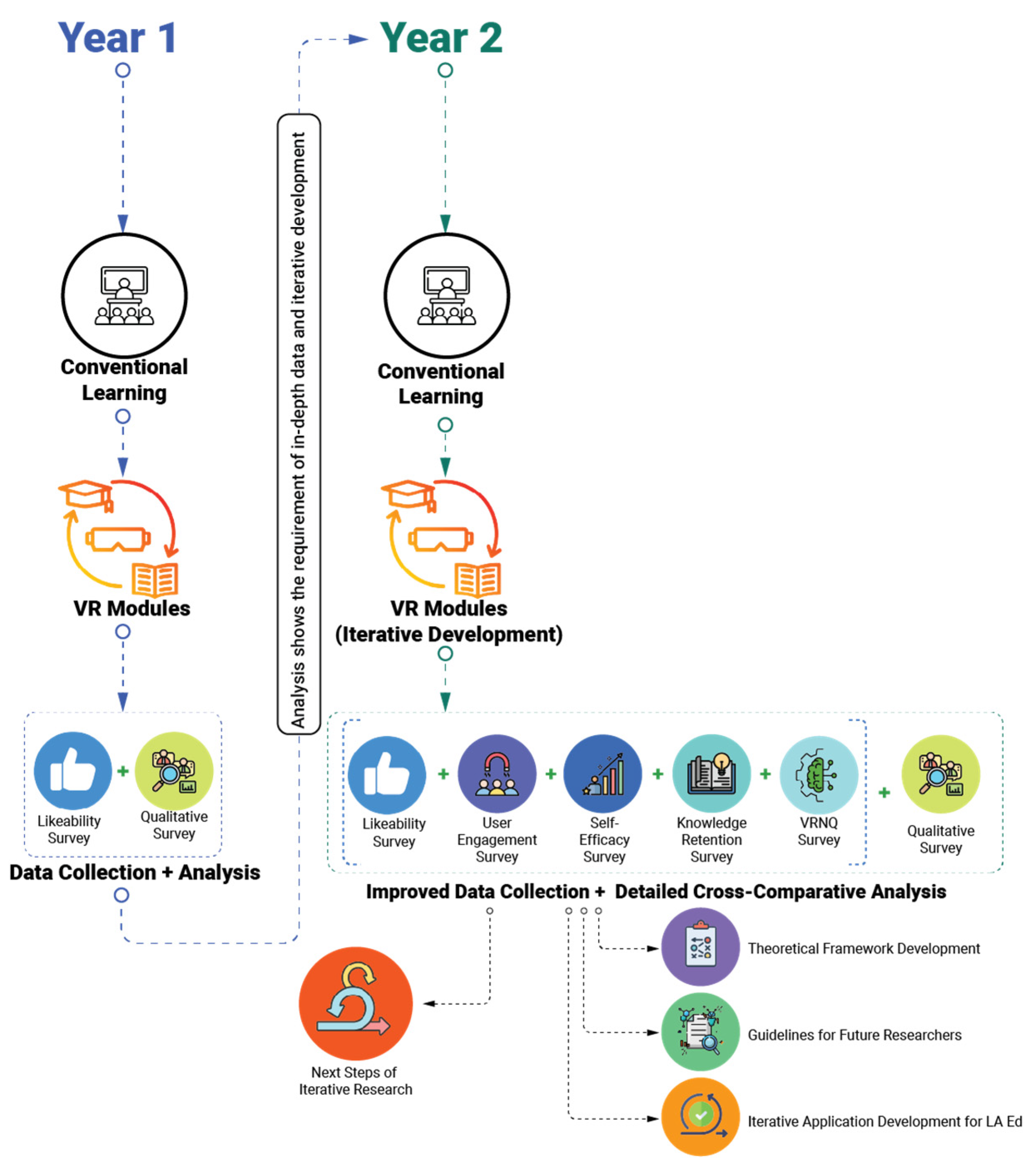




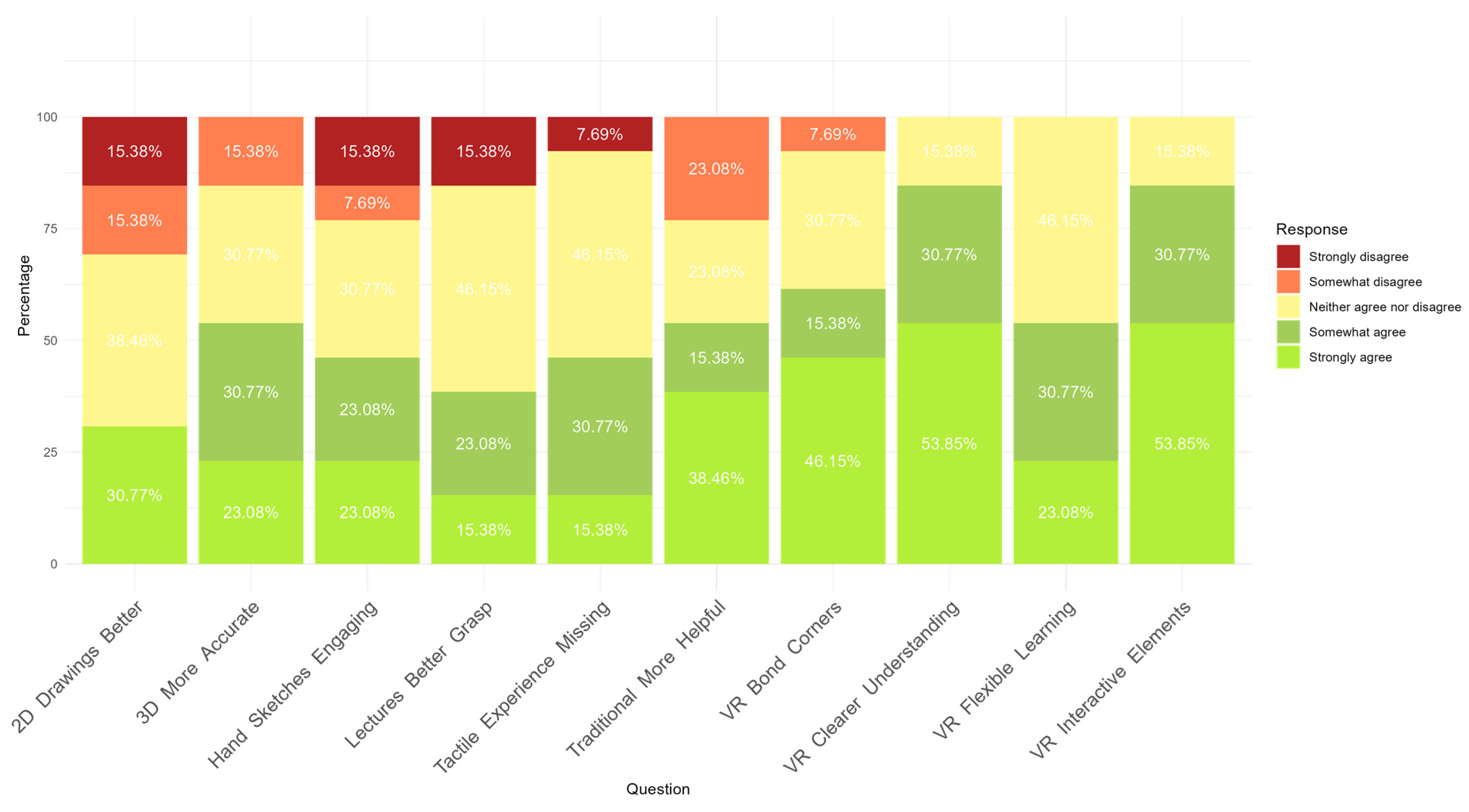
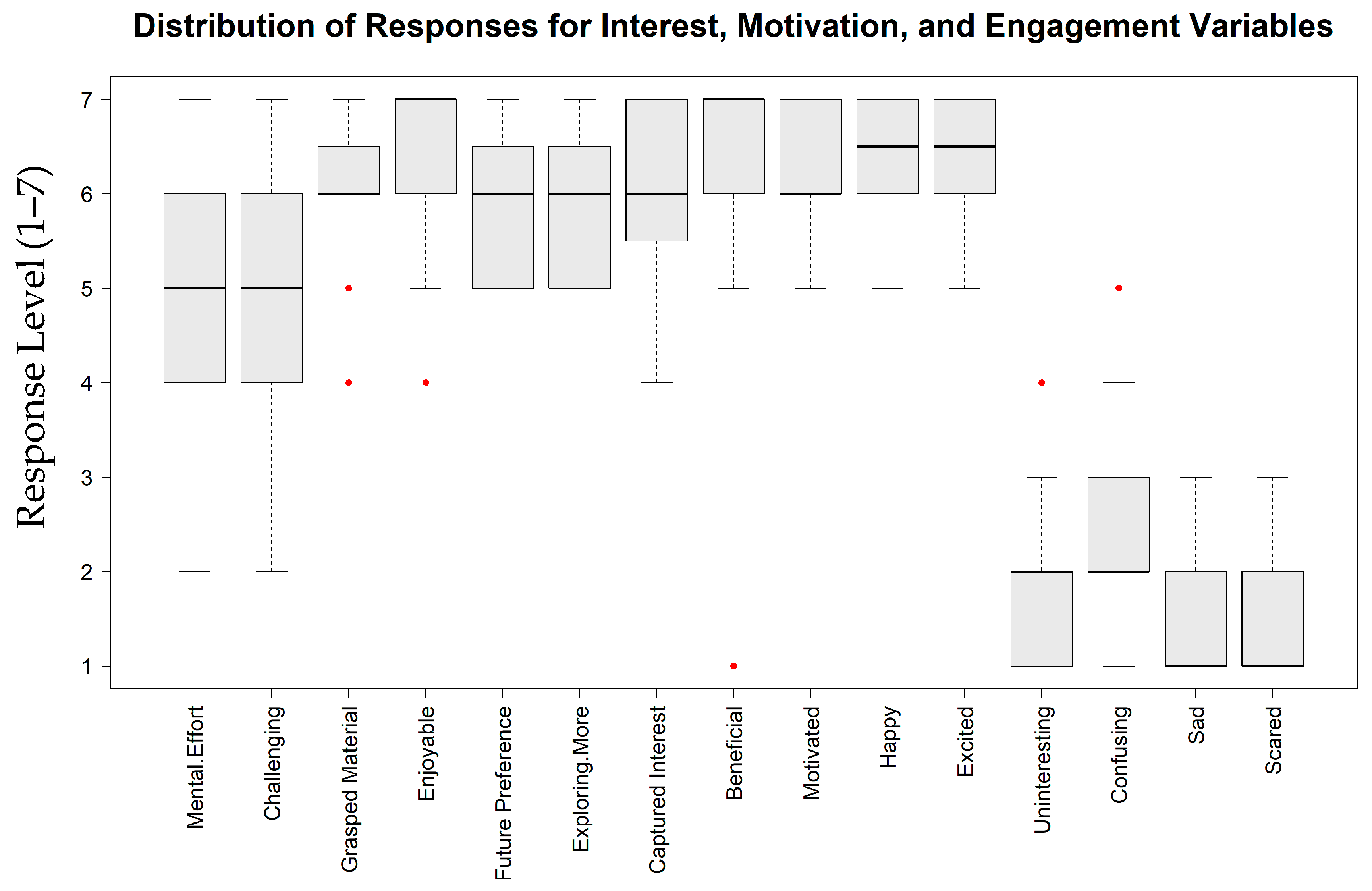
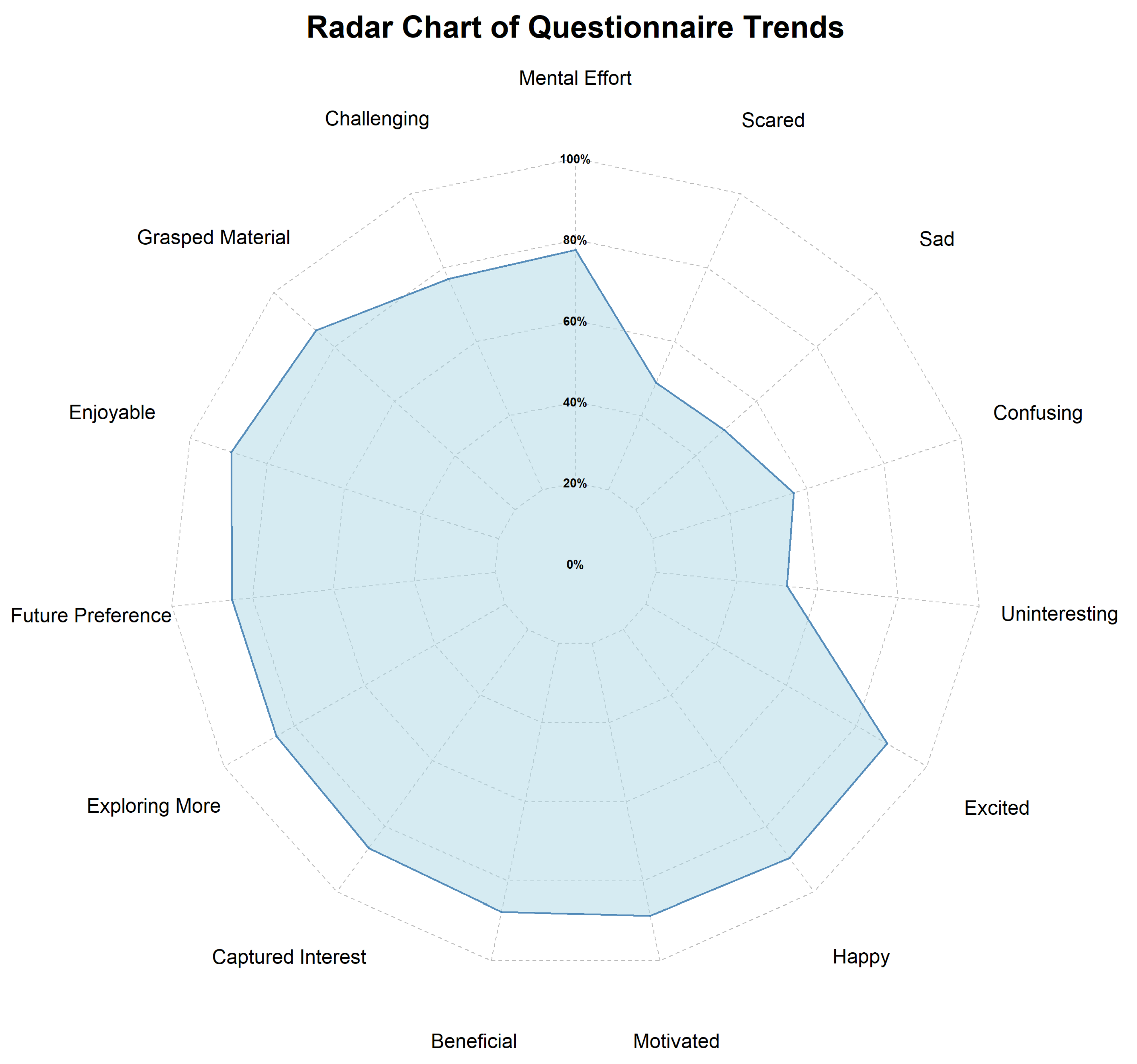


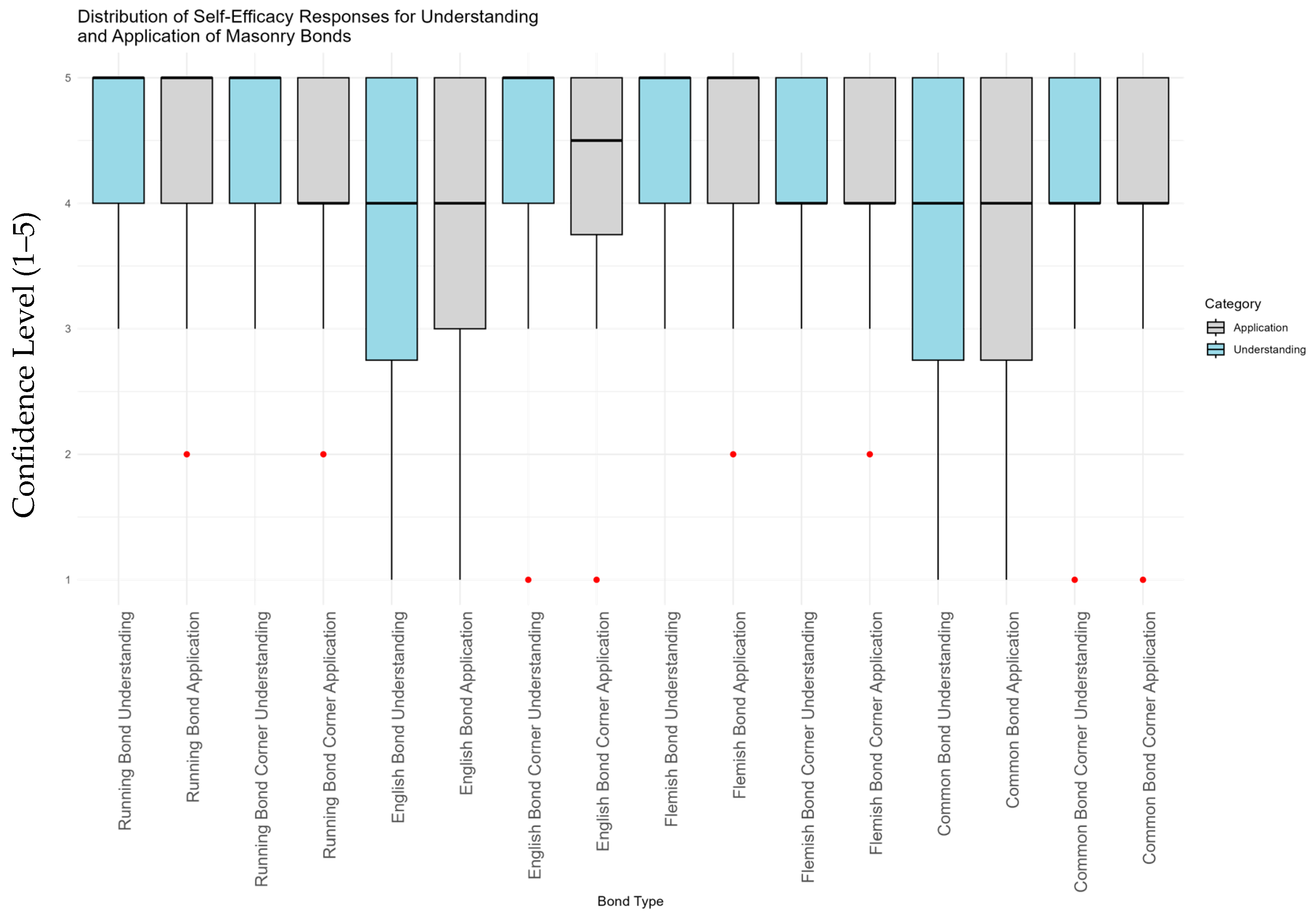
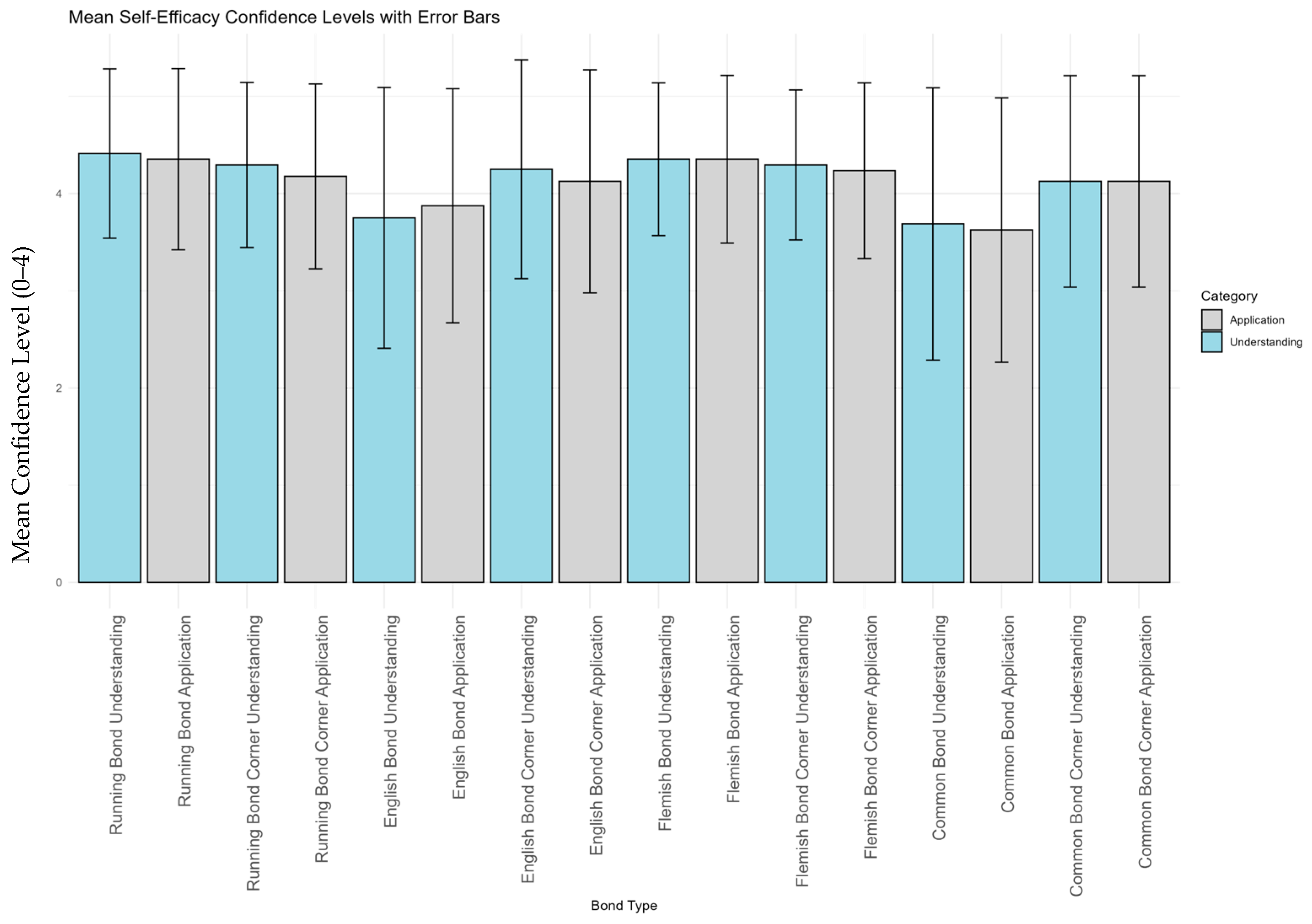
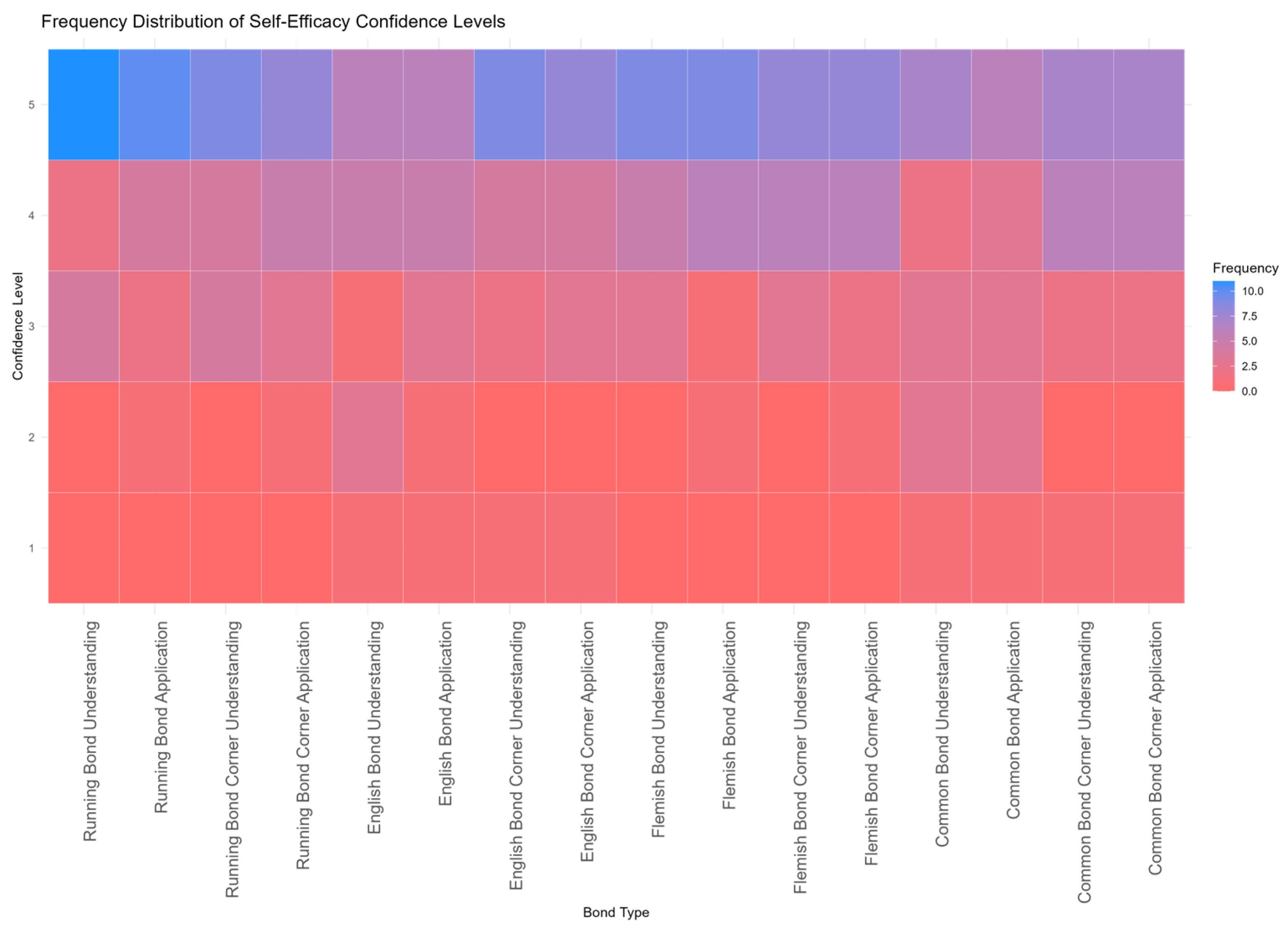
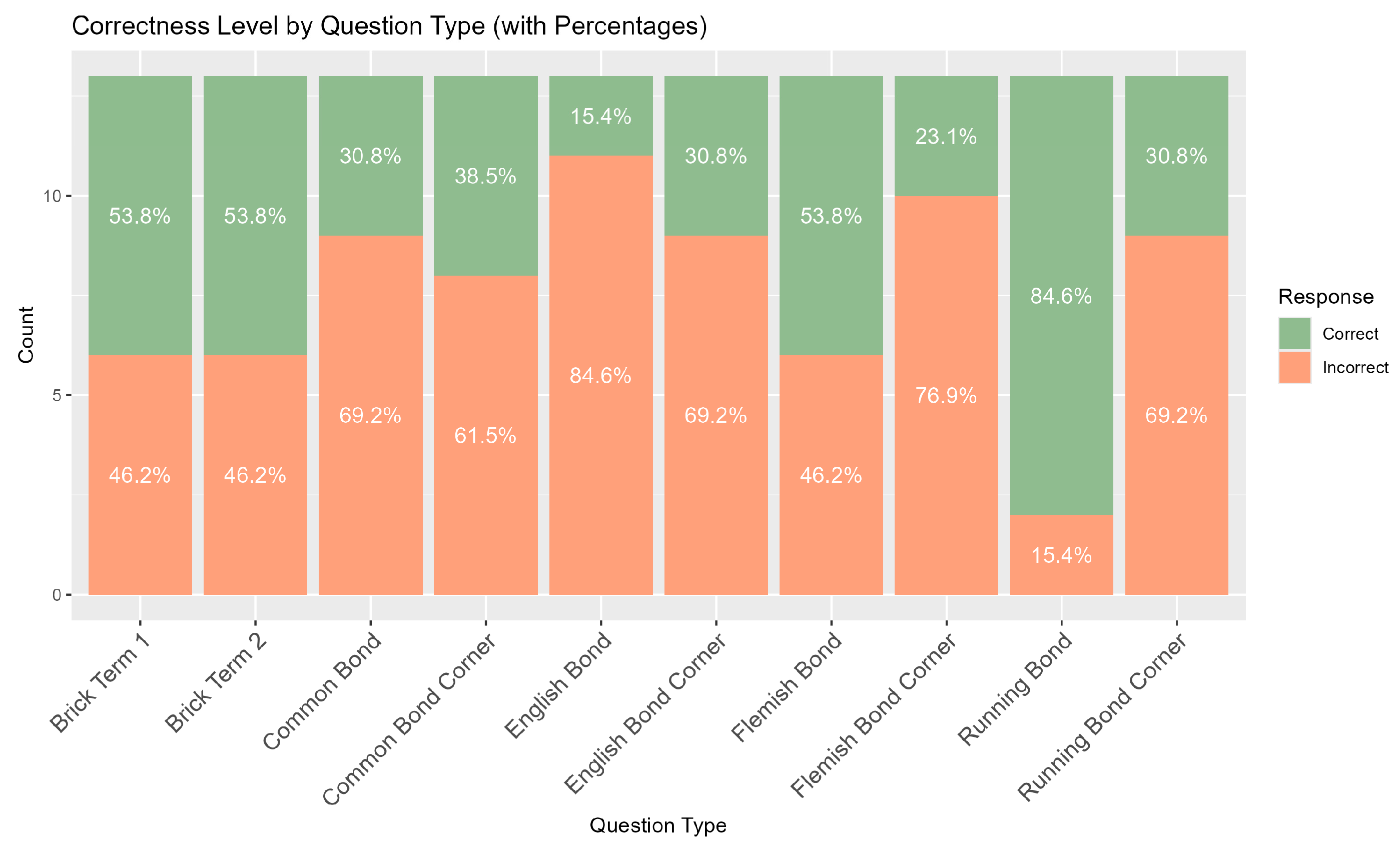

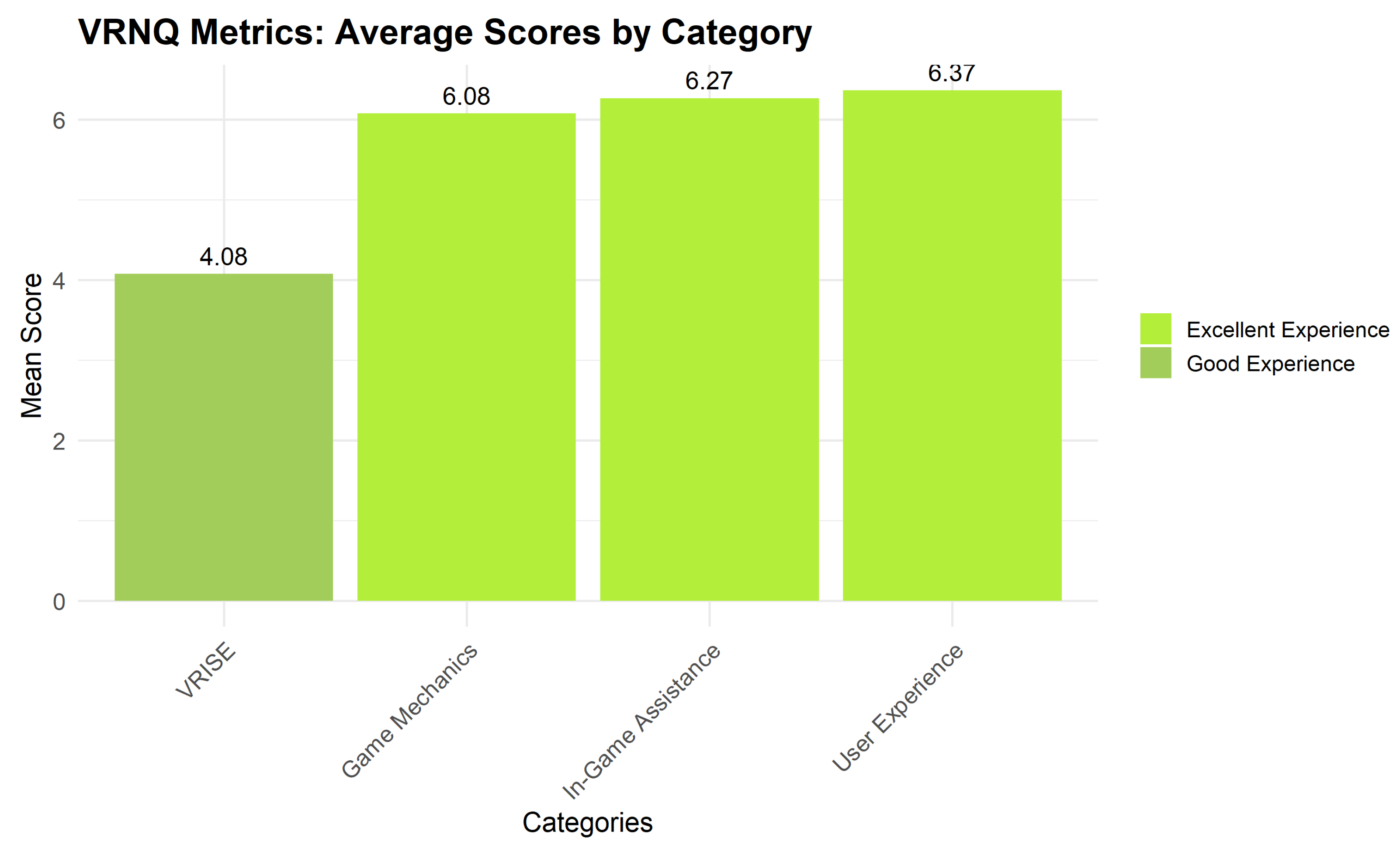

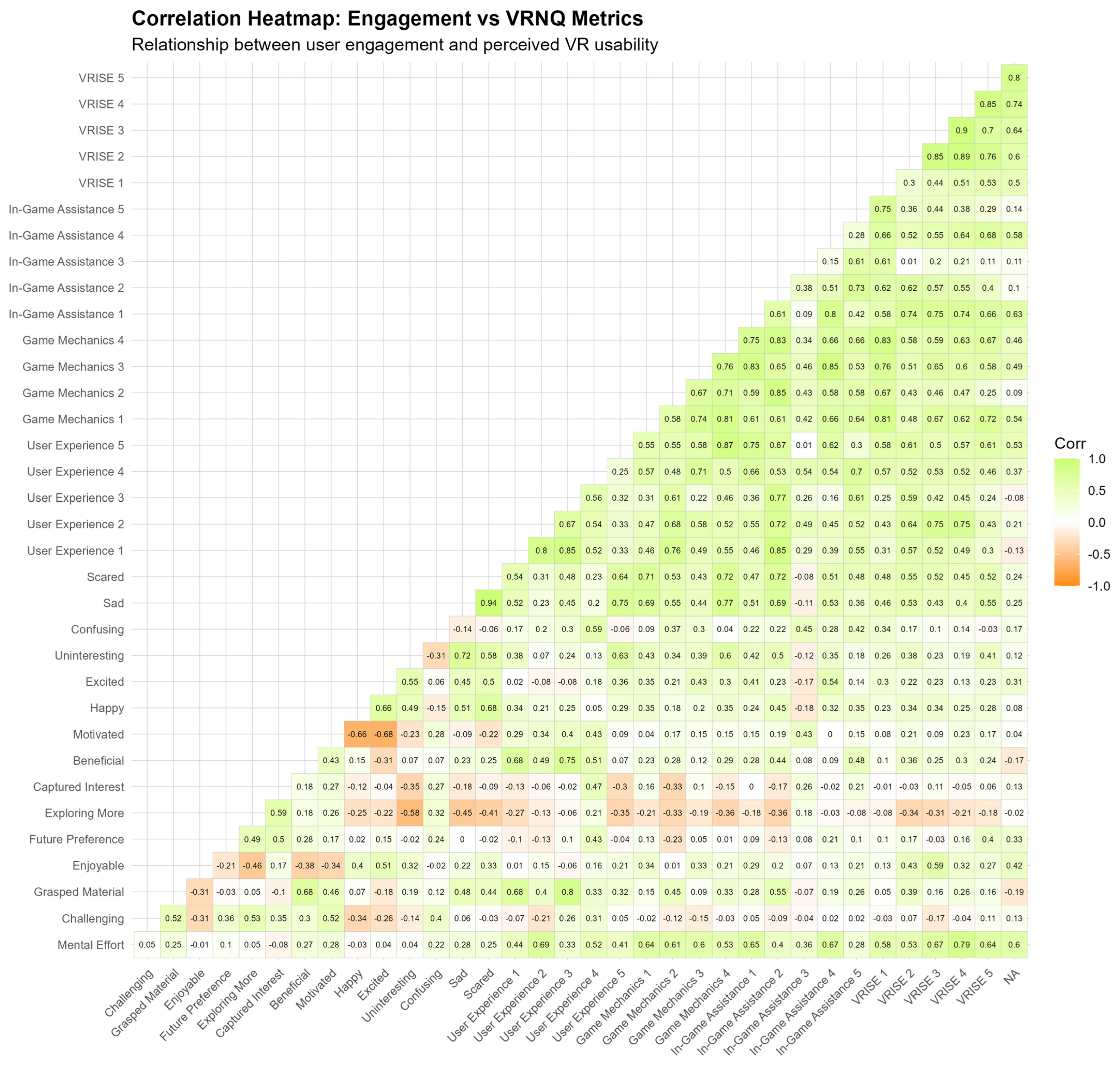
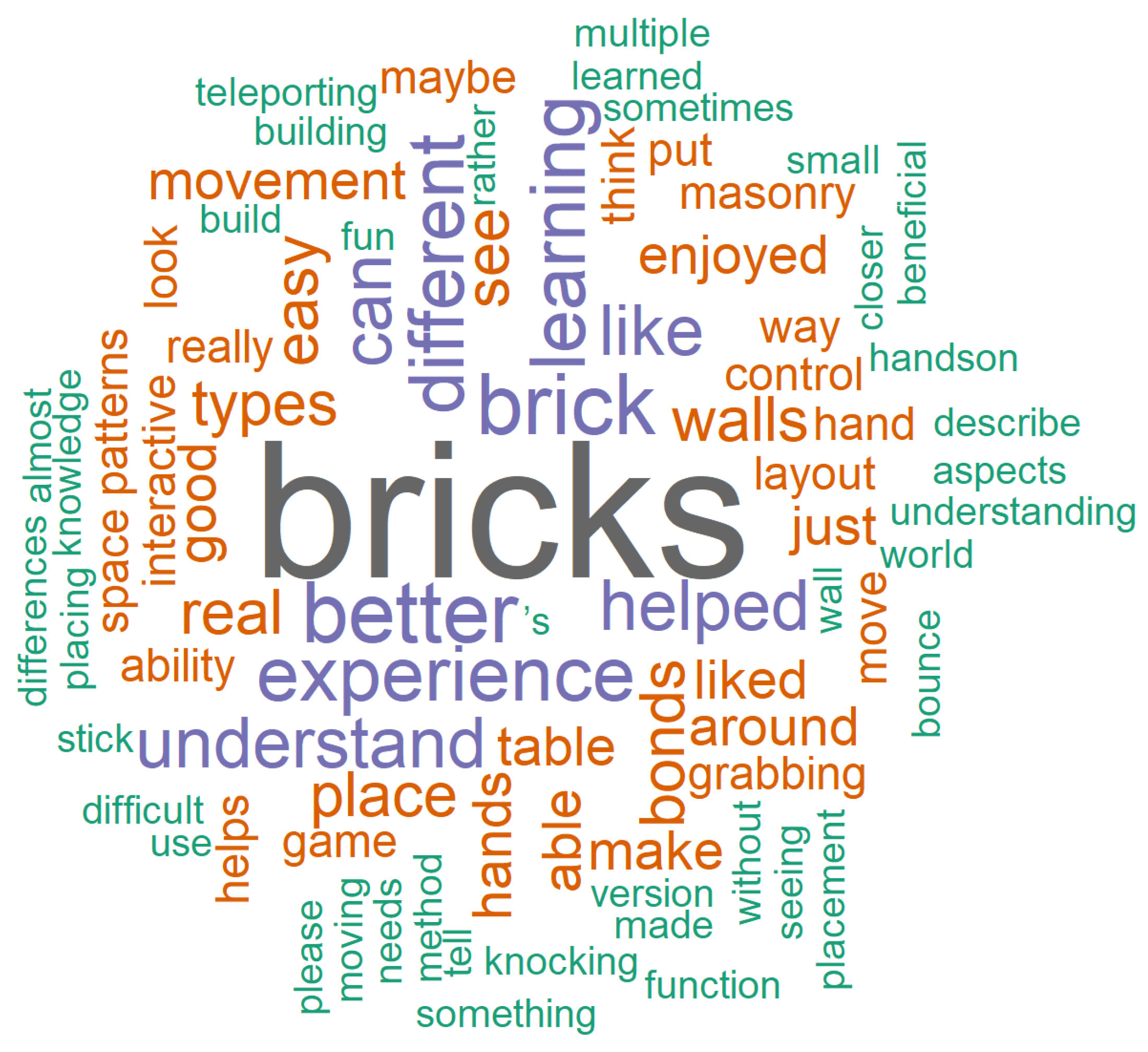
Disclaimer/Publisher’s Note: The statements, opinions and data contained in all publications are solely those of the individual author(s) and contributor(s) and not of MDPI and/or the editor(s). MDPI and/or the editor(s) disclaim responsibility for any injury to people or property resulting from any ideas, methods, instructions or products referred to in the content. |
© 2025 by the authors. Licensee MDPI, Basel, Switzerland. This article is an open access article distributed under the terms and conditions of the Creative Commons Attribution (CC BY) license (https://creativecommons.org/licenses/by/4.0/).
Share and Cite
Andalib, S.Y.; Monsur, M.; Cook, C.; Lemon, M.; Zawarus, P.; Loon, L. Enhancing Landscape Architecture Construction Learning with Extended Reality (XR): Comparing Interactive Virtual Reality (VR) with Traditional Learning Methods. Educ. Sci. 2025, 15, 992. https://doi.org/10.3390/educsci15080992
Andalib SY, Monsur M, Cook C, Lemon M, Zawarus P, Loon L. Enhancing Landscape Architecture Construction Learning with Extended Reality (XR): Comparing Interactive Virtual Reality (VR) with Traditional Learning Methods. Education Sciences. 2025; 15(8):992. https://doi.org/10.3390/educsci15080992
Chicago/Turabian StyleAndalib, S. Y., Muntazar Monsur, Cade Cook, Mike Lemon, Phillip Zawarus, and Leehu Loon. 2025. "Enhancing Landscape Architecture Construction Learning with Extended Reality (XR): Comparing Interactive Virtual Reality (VR) with Traditional Learning Methods" Education Sciences 15, no. 8: 992. https://doi.org/10.3390/educsci15080992
APA StyleAndalib, S. Y., Monsur, M., Cook, C., Lemon, M., Zawarus, P., & Loon, L. (2025). Enhancing Landscape Architecture Construction Learning with Extended Reality (XR): Comparing Interactive Virtual Reality (VR) with Traditional Learning Methods. Education Sciences, 15(8), 992. https://doi.org/10.3390/educsci15080992





